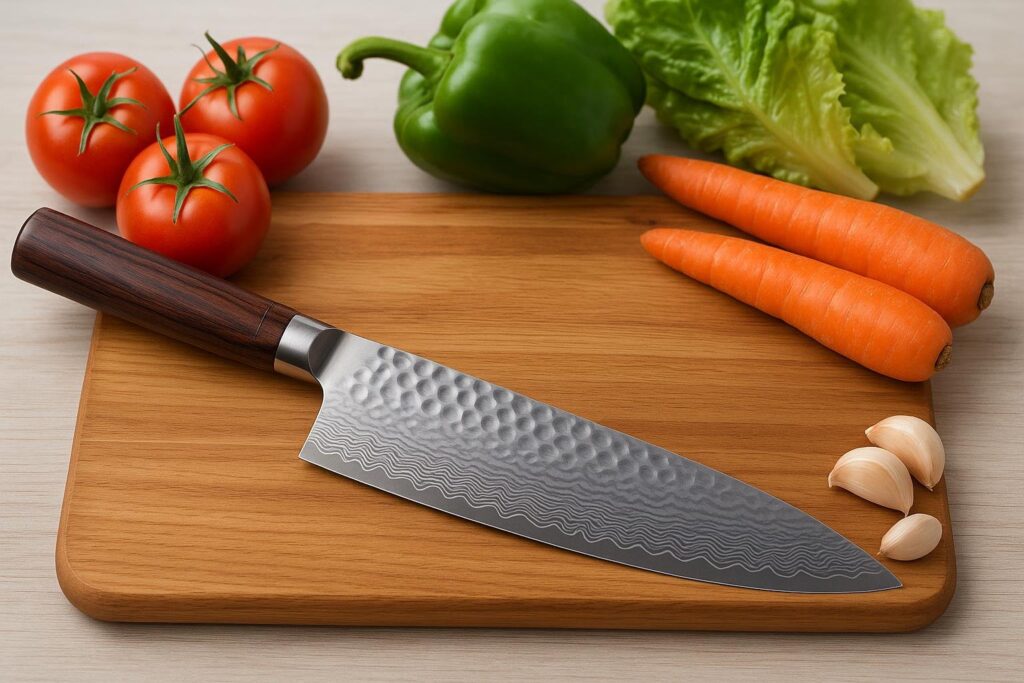
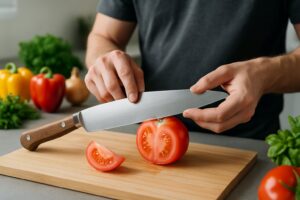

Damascus chef knives bring together beauty and function to the kitchen. The layered steel construction helps the blade stay sharp longer than many other knives. The unique patterns also make each knife look different, turning a kitchen tool into something impressive on the counter or cutting board.
Knife Buzz has researched and tested dozens of chef knives to find blades that combine sharpness, durability, and value. Our top picks combine sharp edges, beautiful patterns, and solid construction that home cooks and professional chefs can rely on.
When shopping for Damascus knives, focus on steel quality and construction method. Some knives use real Damascus steel folding techniques, while others just have a pattern printed on the surface. Handle material and balance also matter for comfort during long cooking sessions.
Tips when buying a Damascus knife:
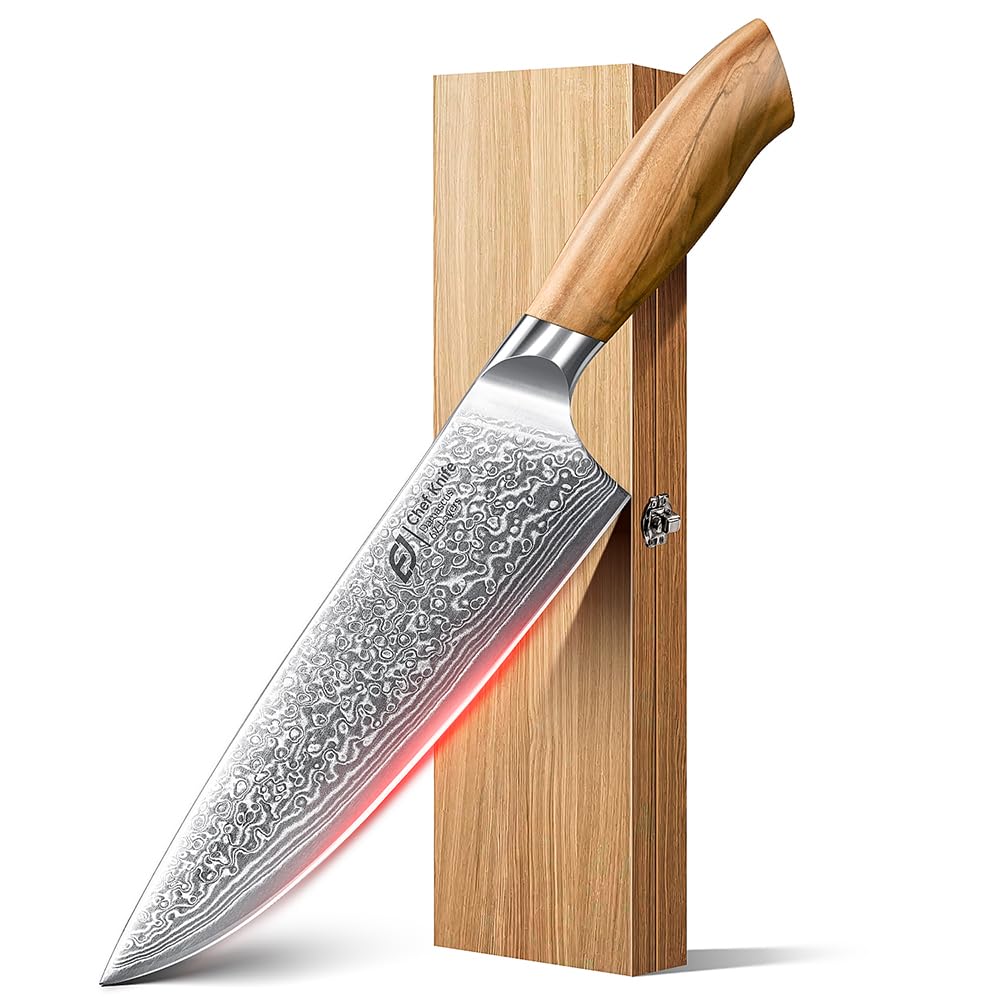
This knife delivers professional-grade performance at a great price with its beautiful Damascus steel blade and comfortable olive wood handle.
Pros
Cons
We tested this knife on everything from delicate tomatoes to tough root vegetables. The 67-layer Damascus steel cuts through ingredients with almost no pressure. The blade glides through meat and fish without tearing or shredding.
The olive wood handle feels natural and keeps hands comfortable during long prep sessions. The grip doesn’t slip when wet, making it safer to use.
This knife arrived sharper than any other we’ve used straight from the box. We sliced paper-thin pieces of onion without any tears. The 15-degree angle on each side creates a razor-like edge that lasts weeks between sharpening.
The wooden gift box makes this knife a great choice for anyone who loves cooking. The Damascus pattern creates unique swirls that catch the light beautifully.

This knife delivers professional-grade sharpness and comfort at a great price point for home cooks.
Pros
Cons
We tested this knife on everything from tough root vegetables to delicate tomatoes. The blade sliced through carrots easily and made paper-thin onion cuts effortless. The weight feels balanced, never too heavy or too light.
The green Pakkawood handle offers a secure grip. Even when our hands got wet from washing vegetables, the handle stayed secure. We used this knife for over an hour of meal prep without wrist strain.
The Damascus pattern looks stunning under kitchen lights. The blade holds its edge well after weeks of regular use. The 8-inch length works well for most cutting tasks without being too bulky for smaller jobs.
Store this knife carefully since the blade is sharp. Use a knife block or magnetic strip rather than tossing it in a drawer. The knife comes in gift packaging that makes it feel premium from the moment you open it.

We found this knife delivers excellent cutting performance for the price, though the plastic handle feels less premium than we expected.
Pros
Cons
We tested this knife on everything from delicate tomatoes to tough carrots. The blade sliced through vegetables with minimal pressure. The 67-layer Damascus steel creates a sharp edge that held up well after weeks of daily use.
The full-tang design provides good balance in your hand. We cooked for over an hour without feeling strain in our wrists. The handle grip stays secure even when wet from washing vegetables.
The plastic handle stands out against the beautiful blade. It feels hollow compared to wood or metal handles on similar knives. The Damascus pattern looks stunning but requires extra care to keep it clean and polished.
The knife comes in a gift box with magnetic closure and includes a protective blade cover. For the price, this knife performs well above what we expected from a budget Damascus option.

This knife delivers professional-grade chef knife with stunning Damascus steel construction that makes it worth the premium price for serious home cooks.
Pros
Cons
We found this knife cuts through ingredients with precision. The 67-layer Damascus steel construction creates a blade that glides through vegetables and meat easily.
The ergonomic handle offers a comfortable grip during extended use. The stabilized wood and resin combination provides excellent balance and reduces hand fatigue. The full tang design distributes weight evenly across the knife.
The presentation impressed us right out of the box. The leather sheath protects the blade well when storing or transporting the knife. The gift packaging makes this an excellent choice for anyone who takes cooking seriously.
This knife requires careful maintenance to preserve its beauty and performance. Hand washing and proper drying prevent corrosion and keep the Damascus pattern looking its best. The investment pays off with a tool that performs like professional kitchen equipment.

This knife offers professional-grade performance with a razor-sharp edge and balanced design, making it a strong choice for serious home cooks.
Pros
Cons
This knife glides through vegetables and meat with ease. The Damascus steel blade feels substantial but not heavy, and the grip stays comfortable even after extended use.
The fiberglass handle offers durability and a textured grip that doesn’t slip when wet. The mosaic pin adds a nice visual touch.
With the included sheath and case, storage is simple and safe. The sheath fits well for drawer storage, and the case works for transport or gifting. Both protect the blade effectively.
The blade keeps its sharp edge longer than many other knives. With proper care and occasional sharpening, you can maintain its performance over time.

This knife provides exceptional sharpness and durability at a reasonable price for home cooks and professionals.
Pros
Cons
This knife glides smoothly through everything from delicate tomatoes to tough root vegetables. The blade stays sharp even after months of regular use. The Damascus pattern helps food release from the blade during cutting.
The G10 handle feels solid and secure, even when wet. The balance point sits where your fingers grip the blade, making precise cuts easy.
After several weeks of use, the knife maintains its edge better than many others in this price range. The 67-layer construction improves daily performance. Hand washing and immediate drying keep the blade looking its best.

We have also included several Damascus chef knife set options in this review. The Shan Zu Damascus Chef Knife Set suits home cooks who want professional-quality blades with great durability and sharpness at a fair price.
Pros
Cons
This knife set arrives impressively sharp. The blade cuts cleanly through tomatoes and onions, maintaining its edge well after weeks of use.
The G10 handle offers comfort during long cutting sessions and provides a secure grip, even with damp hands. The balance point at the bolster adds stability and control.
The Damascus pattern is more subtle than shown in product photos and requires good lighting to see clearly. The blade can show water spots, so dry it immediately after washing to keep it looking its best.

This three-piece Damascus knife set offers excellent cutting performance and build quality at a reasonable price.
Pros
Cons
This Asety knife set arrives incredibly sharp. The 67-layered steel construction creates beautiful patterns and delivers consistent cutting performance. Each knife feels substantial without being too heavy.
The G10 handle provides a secure and comfortable grip, even during long prep sessions. The full tang construction adds excellent balance from tip to handle.
These knives slice cleanly through everything from tomatoes to root vegetables. The 15-degree edge angle allows for precise cuts. The chef’s knife handles most tasks, while the Santoku knife excels at chopping and the utility knife works well for smaller jobs.
Since the Damascus steel can show water spots, hand wash and dry the blades immediately. The sharpness lasts much longer than typical kitchen knives, making the extra care worthwhile.

This comprehensive knife set delivers impressive cutting performance and storage convenience for home cooks seeking professional-quality tools.
Pros
Cons
This knife set remains sharp after weeks of daily cooking tasks. The magnetic block holds knives securely without sliding them into slots that can dull the edges.
The Damascus pattern gives these knives a premium look. Each blade cuts through vegetables and meat with minimal pressure. The ergonomic handles reduce strain during longer prep work.
The magnetic storage system makes it easy to access all your tools. Extra knives from other sets also stick to the sides. The block feels solid and stable on the counter.
The 14-pound weight makes it tough to move when cleaning, and the hand-wash requirement adds extra time since you can’t use the dishwasher.
Damascus knives have unique patterns, specific care needs, and varying quality levels. Price ranges differ between Japanese and Western styles, and certain brands excel in different markets.
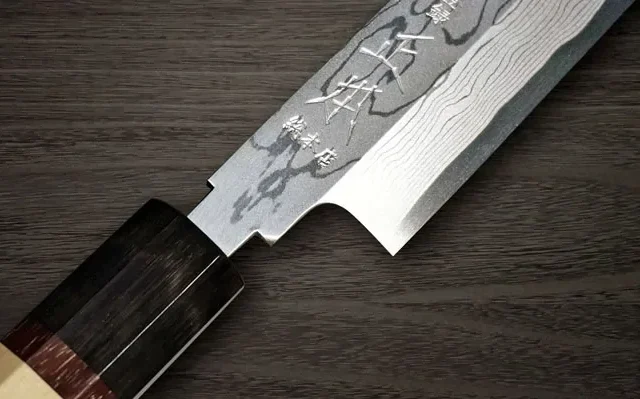
Look for genuine Damascus steel construction with visible layered patterns. The blade should feel balanced in your hand with the weight distributed evenly.
A sharp edge that holds its sharpness is essential. Quality Damascus knives maintain their cutting ability for weeks with regular use.
The handle should fit comfortably in your grip. Wood, resin, or composite materials work well when they resist moisture and cracking.
Full tang construction means the blade extends through the entire handle. This design provides better durability and balance than partial tang knives.
Japanese Damascus knives typically use harder steel than Western versions. The steel often reaches 60-62 HRC hardness, making the edge sharper and more precise. Western Damascus knives usually have softer steel around 56-58 HRC. This makes them easier to sharpen but they may not hold an edge as long.
Japanese knives often feature thinner blade profiles. The thin design cuts through food with less resistance but requires more careful handling. Western styles tend to be heavier and more robust. They can handle tougher cutting tasks but may not provide the same precision as Japanese designs.
We recommend Dalstrong as a top American brand for Damascus knives. They offer styles ranging from Japanese-inspired designs to Western chef knives.
Wusthof produces some Damascus lines in their German facilities. Their knives blend German craftsmanship with Damascus steel patterns.
Shun Cutlery makes high-quality Damascus knives using Japanese techniques. Many models feature VG-MAX steel cores with Damascus cladding.
Miyabi offers premium Damascus options with authentic Japanese styling. Their knives use traditional Japanese steel types and handle materials.
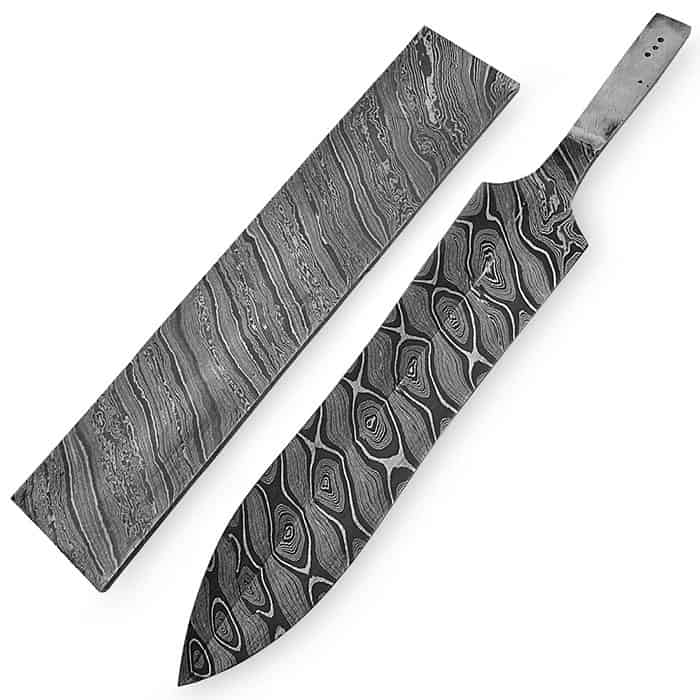
Check seller ratings and return policies before purchasing. Look for sellers with ratings above 95% and clear return terms.
Read product descriptions to understand the steel type. Some Damascus knives use pattern welding, while others have etched designs that only look similar.
Check if the listing includes blade specifications like hardness rating. This information helps you determine the knife’s performance and durability.
Make sure the knife comes with proper packaging and care instructions. Quality Damascus knives should include cleaning and storage guidance.
Hand wash Damascus knives immediately after use with mild soap. Do not put them in the dishwasher because this can damage the steel and handle.
Dry the blade completely before storing to prevent rust. Damascus steel can corrode if left wet for too long.
Oil the blade monthly with food-safe mineral oil. This protects the steel and makes the Damascus pattern stand out.
Sharpen the knife professionally every 6-12 months to keep the edge. Avoid electric sharpeners because they can damage the blade.
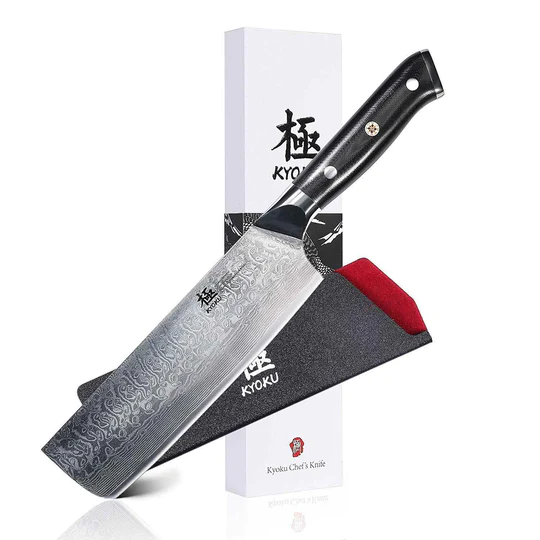
Knife Buzz offers independent product reviews on a wide range of knives used in the kitchen, home, and outdoors. We make it easy for you to find the right knife at the best price.